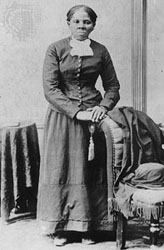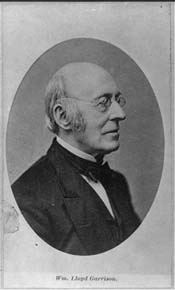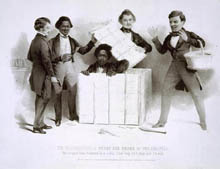

Harriet Tubman
William Llyod
Garrison |
I had reasoned this out in my mind, there was one of two things I had a right to, liberty or death; if I could not have one, I would have the other. — Harriet Tubman Enslave a people and they will find a way to escape. As the Underground Railroad developed, a metaphor unfolded that grew into a culture and myth of its own. People were passengers, although they never set foot on a train car; homes were stations, but there were no tracks; conductors led a group of people but never collected tickets. It was a road to freedom that followed the drinking gourd, a code name for the Big Dipper and North Star. When did the Underground Railroad begin? How many people escaped between the American Revolution and the Civil War? What were the code words used on the Underground Railroad, and who were the people who risked their safety for a cause that they believed was just? Let's travel back in time and learn about the Underground Railroad. Background Information Aboard the Underground Railroad Aboard the Underground Railroad showcases 55 historic places that are listed in the National Park Service's National Register of Historic Places. Sketches of the people associated with each home shed light on the historical significance of the abolitionist organizations of the time. A map is included with the most common directions for escape on the Underground Railroad. Individual state maps marking the location of the historic properties make it an easy site to navigate. History Channel Underground Railroad The History Channel is a good starting point for information about the beginnings, people, and places ofthe Underground Railroad. Biographies accompanied by photographs describe seven prominent figures in the movement. To better understand the reality versus the myth of the Underground Railroad, a series of primary source documents are presented along with a teacher's guide for discussion. Rounding out the site is a section on slavery in America covering the Abolitionist Movement, the Civil War, the Dred Scott Case, Fugitive Slave Law, and Uncle Tom's Cabin. Kentucky's Underground Railroad Read about the origination of the term Underground Railroad. Compare the timelines outlining major events in Kentucky and American history that contributed to the Thirteenth Amendment to the U.S. Constitution, making slavery illegal and extending civil rights to former slaves. Then, view the documentary Kentucky's Underground Railroad—Passage to Freedom using RealPlayer. Each segment features a topic and summary. This is a great resource. National Geographic Underground Railroad National Geographic has created an excellent interactive trip on the Underground Railroad. Highlights include listening to "Steal Away" and meeting people associated with the Underground Railroad and the Abolitionist movement. National Underground Railroad Network The National Park Service is implementing a national Underground Railroad program to coordinate preservation and education efforts nationwide and to integrate local historical places, museums, and interpretive programs associated with the Underground Railroad into a mosaic of community, regional, and national stories. The site includes a database of historic sites and programs by states. Each is categorized by state and contains a brief description. On the main page are links to regional stories about the Underground Railroad. Personal Narratives and Primary Sources Harriet Tubman from America's Library Harriet Tubman was not only a conductor on the Underground Railroad, but a spy for the Union army during the Civil War. The Library of Congress has gathered together primary source material to supplement the narrative about her adventures. This is a great starting point for factual information. Students will be fascinated by the story of Henry Box Brown, who mailed himself to freedom. He traveled 350 miles from Richmond, Virginia, to Philadelphia, Pennsylvania. For 27 hours he was enclosed in a box 3-feet long and 2-1/2-feet deep. His experience was made famous by his narrative, published in 1851. Influence of Prominent Abolitionists Illustrations, documents, and broadsides illuminate the influence of the Abolitionists during the 19th century in American history. Featured are publications from the Anti-Slavery Convention, the Anti-Slavery Almanac for 1840, the North Star, Two Speeches by Frederick Douglass, and Make the Slave's Case Our Own by Susan B. Anthony; illustrations of the Anti-Slavery Meeting on the Boston Common, and title card for Uncle Tom's Cabin; and a broadside of Anthony Burns, who was arrested and tried under the Fugitive Slave Act of 1850. Garrison was an outspoken Abolitionist who expressed his opinions through The Liberator, an anti-slavery publication he began in 1831. You will find a brief biography, a letter from Harriett Beecher Stowe to Garrison, and his famous editorial, "To the Public," which appeared in the first issue of the newspaper. William Still is sometimes called the Father of the Underground Railroad. He was an ardent abolitionist and the first African American to join the Pennsylvania Abolition Society. His home was one of the busiest stations on the Underground Railroad, affording him the opportunity to interview many of the fugitives. In 1879, Still published The Underground Railroad: A Record of Facts, Authentic Narratives, Letters, etc. This was one of the first major works about the Underground Railroad and contained many firsthand accounts. The full text of the book is available along with 70 illustrations. Songs Explanation of Follow the Drinking Gourd "Follow the Drinking Gourd" is a song filled with coded references. At this site, the verses are deciphered and explanations are given as to the meanings behind the song. Sing along to the tune of the "Drinking Gourd" at this folk music site. Background information attributes the spread ofthe song to an itinerant carpenter, Peg Leg Joe, who traveled throughout the South, passing the tune to slaves. Steal Away: Songs of the Underground Railroad If you are looking for a commercial source for songs, visit this site. You can listen to samples in either real audio or wave files. Kim and Reggie Harris, contemporary artists, present these songs "to honor the tradition and spirit of the music through the prism of their own musical experience and evolution."Descriptions about the songs give insight into the dual meanings many of them had during that era. Some of the songs included in the collection are "Oh Freedom," "Deep River," and "Go Down Moses." Lesson Sweet Clara and the Freedom Quilt This lesson focuses on the book Sweet Clara and the Freedom Quilt by Deborah Hopkinson with illustrations by James Ransome. Students learn about the geographic concepts needed to examine culture and the processes needed to be a good citizen in American society. Many engaging activities will inspire students to problem solve and think in a critical way. These activities are designed to teach children about the secret codes that might have been used on the Underground Railroad. There is debate over wheather or not quilts contained secret codes. Community Connections Have students locate Underground Railroad stations and their locations. Plot them on a map and see if any patterns emerge. Research and analyze first-person accounts. Have students write about what they believe were the major hardships while traveling on the Underground Railroad. What would they have done if they were in the same situation? Or make an Underground Railroad quilt. No matter what activities you choose, your students will have a new appreciation for the Underground Railroad and its impact on American history. |
National Standards History Standards Standard 4A 5-12 Explain the fundamental beliefs of abolitionism and compare the antislavery positions of the "immediatists" and "gradualists" within the movement. 9-12 Compare the positions of African American and white abolitionists on the issue of the African American's place in society.
Henry Box Brown
|
||
|
||||
Updated January 5, 2019 © 1996 - 2019 Linda C. Joseph All Rights Reserved All CyberBee Graphics are Trademarked Graphics by Darlene Vanasco/Creative Director Erika Taguchi/Designer & Illustrator Hosting Provided by Iwaynet |
||||


